The SmartRunner Matcher uses the laser light section technology to capture height profiles and compares them with a taught reference profile. With up to 32 profiles stored in the sensor, it is perfect for positioning as well as presence and completeness checks of guided components.
The laser profile sensors are based on the unique SmartRunner technology. For the first time, this combines the proven laser light section technology with a 2-D vision sensor including LEDs and offers maximum performance in a compact sensor housing.
SmartRunner Matcher: The Specialist for Profile Matching
The SmartRunner Matcher combines application-specific profile detection with an integrated evaluation in a compact housing. The control unit of the laser profile sensor is optimized to detect deviations from a previously taught-in height profile.
First, a reference profile is taught in via an intuitive operating wizard. In addition, the permitted position and component deviations are defined. Based on this, the sensor verifies the detected profile of the object and its correct position via profile matching. Moreover, variants are available with further functions such as the use and storage of up to 32 profiles on one sensor and the output of the object position deviation. These offer different detection ranges of up to 700 mm distance as well as 300 mm X detection range.
The SmartRunner Matcher can be commissioned easily and intuitively: via the Vision Configurator—the uniform user interface for all vision sensors from Pepperl+Fuchs—via Data Matrix control code or via guided operation and parameterization with the software wizard.
Typical Applications
- Detection of small parts like screws, clamps, and studs
- Completeness check for battery cells, pens, pills, etc.
- Position check and output for boxes, pallets, and other objects
How It Works
This is how the detection of object contour, position and distance works with the Matcher:

Since not every object is the same, a suitable object tolerance must be defined. This is done by defining an envelope curve around a taught-in profile (1). Depending on this, quality values are automatically determined, from which quality threshold values can then be derived to distinguish between good and bad parts. Users can freely define how high the detection sensitivity of the sensor should be (2). Furthermore, displacement tolerances often result from trigger tolerances. With the Matcher, these can also be set in 0.1 mm steps in the X and Z directions so that they do not influence the measurement result (3). The SmartRunner then reliably detects deviating profiles as “Bad” (4).
Highlights
- Rugged and cost-effective presence, completeness, and position detection of components
- Precise profile matching, even with different surface structures, ambient light, and varying operating distances
- Independently adjustable object and offset tolerances and separate data output
Az alábbi specifikus alkalmazási példák mutatják a SmartRunner Matcher több lehetséges felhasználását:
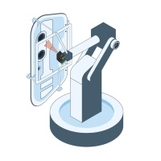
A járműiparban az autók karosszériáit előre gyártott lemezekből hegesztik össze. Ha a lemez nem teljes vagy hibás, a hibát észlelni kell, és a hibás lapot el kell távolítani a gyártásból. A SmartRunner Matcher optikai szekcióérzékelő technológiát alkalmaz a tárgyak észlelésére, profil-összehasonlítást használva, hogy igazolja az alkatrészek teljességét …
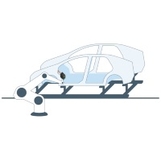
A járművázak összeállítása során a részegységeket kötőelemekkel, így tőcsavarokkal, csavarokkal és kapcsokkal rögzítik egymáshoz. A SmartRunner Matcher észleli, hogy ezek az alkatrészek jelen vannak-e a megfelelő helyen, és jelzést küldenek a vezérlőrendszernek, ha egy kötőelem is hiányzik …
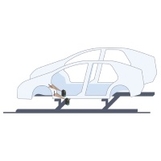
A működés közbeni zajszint csökkentése érdekében a váz több pontjára szilikonos rezgéscsillapítókat, más néven párnákat ragasztanak fel. Annak biztosítására, hogy a rezgéscsillapítók a megfelelő helyre kerültek, a SmartRunner Matcher megtanulja az egyes „ragadós” részek profilmagasságát, és az aktuális profilmagasságot összeveti a referenciaprofillal....
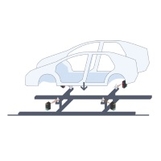
A járműipari gyártásban az éppen feldolgozott autókarosszériát különböző munkaállomásokra viszik szállítóplatformokon A szállítóplatform-csavarok rögzítik a karosszériát a szállítóplatformhoz, és a karosszérián található furatokba vannak benyomva. A folyamat biztonságosságának garantálására a SmartRunner a művelet előtt ellenőrzi a szállítóplatform-csavarok pozícióit.
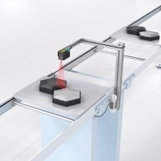
A munkadarabok vagy nyersanyagok előállítási és feldolgozási rendszerekbe történő adagolására gyakran robotrendszereket és kezelőrendszereket használnak. Mielőtt a robot felveszi az adagolt elemeket, ellenőrizni kell a munkadarab-hordozó jelenlétét (jelenlét felügyelete) és az anyag pozícióját (pozíciófelügyelet). A SmartRunner Matcher mindkét érzékelési feladatot egy lépésben hajtja végre.
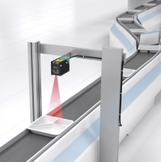
A készételek előállításakor gyakran használnak több kis rekeszre osztott műanyag tálcákat az élelmiszeriparban. Annak biztosítására, hogy az étel összetevői a megfelelő rekeszbe kerültek, ellenőrizni kell az egy színű, fehér tál elrendezését. A SmartRunner Matcher egyértelmű érzékelési eredményeket biztosít még az ilyen kihívást jelentő környezeti tényezők esetén.







 +36 88 545 902
+36 88 545 902